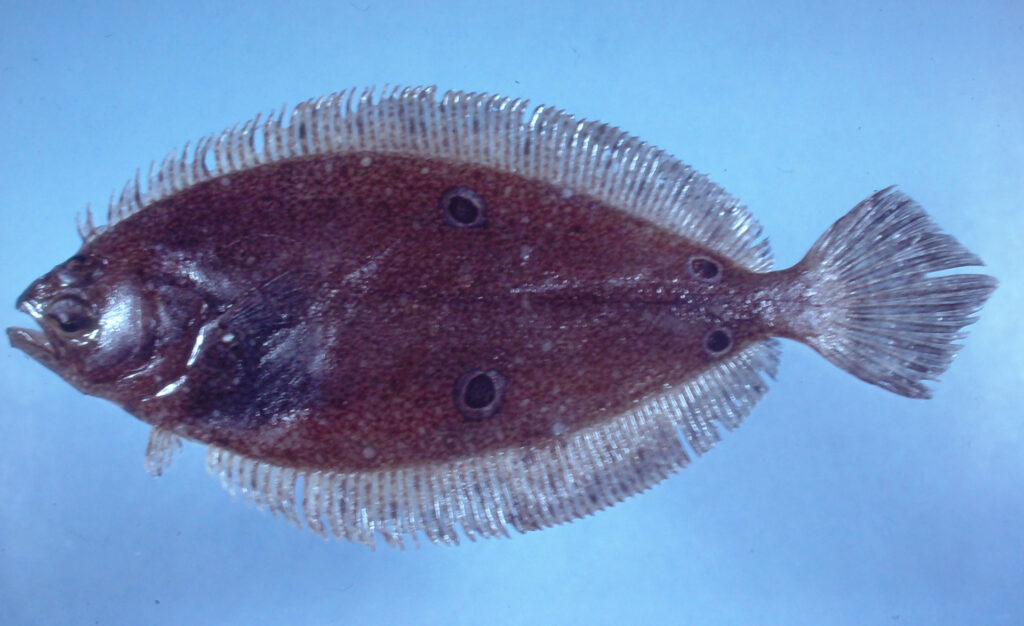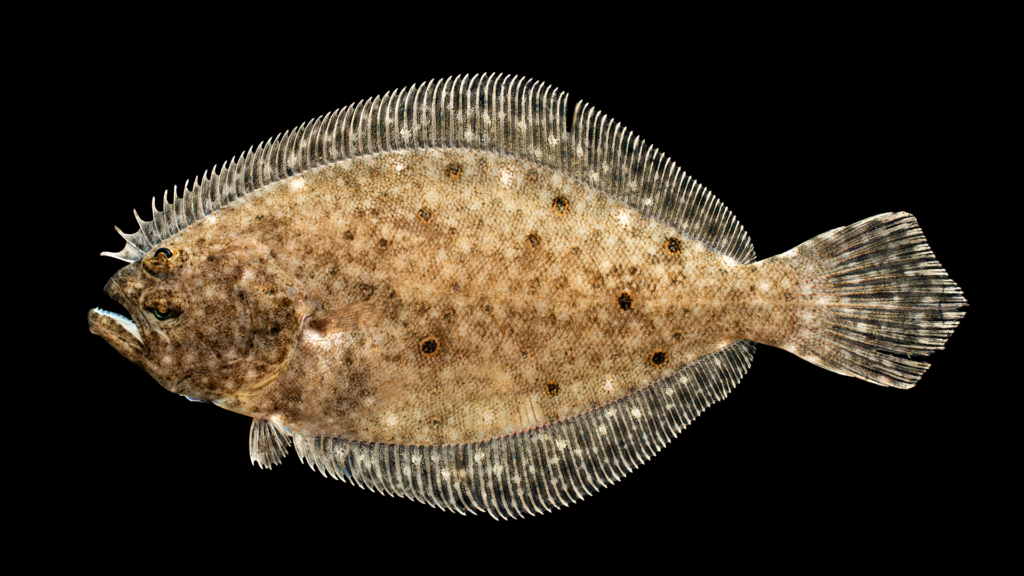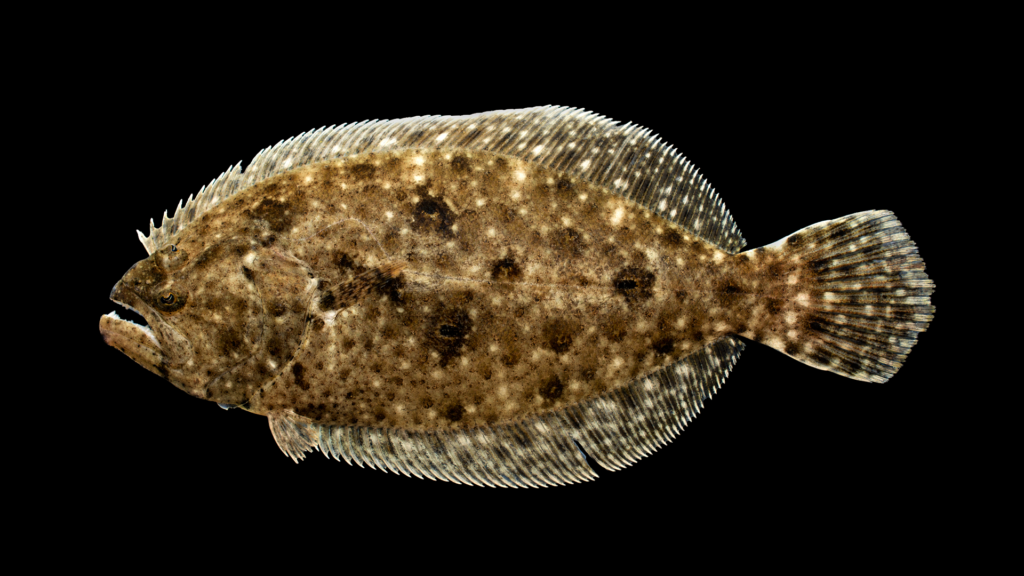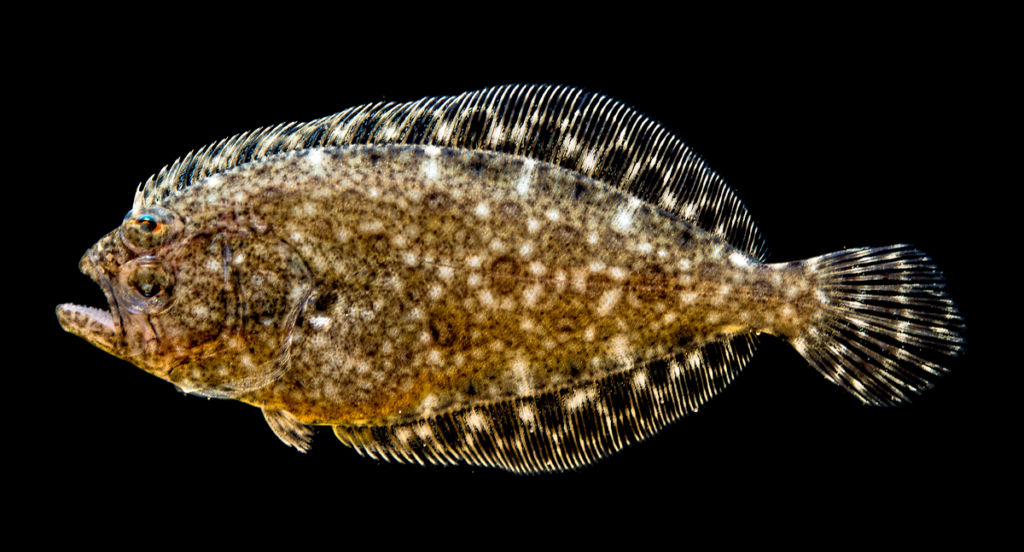
| Family | Scientific Name | Author | Year | Common Name |
| Paralichthyidae | Paralichthys oblongus | (Mitchill) | 1815 | Fourspot Flounder |
Paralichthys oblongus
Unique Characteristics: Lateral line distinctly arched above pectoral fin on ocular side and prolonged below inferior eye. Pelvic fins symmetrically or nearly symmetrically placed on either side of midventral line (base of neither pelvic fin on midventral line). Urinary papilla on ocular side. Branched caudal-fin rays 13. Pelvic-fin rays of ocular side not longer than rays of blind side. Anterior rays of dorsal fin not prolonged. Four large dark ocelli on ocular side of body, arranged in a trapezoid with 2 in midbody (one above the other on opposite sides of the lateral line) and 2 on the body (one above the other on opposite sides of the lateral line) at a point slightly anterior to caudal peduncle. Eyes relatively large and close set, nearly meeting, separated only by a narrow ridge. Lower-limb gill rakers 7-11. Lateral-line scales 63-95. Dorsal-fin rays 71-86. Anal-fin rays 58-72.
Similar Species:
Summer Flounder
Paralichthys dentatus
Gulf Flounder
Paralichthys albigutta
Summer Flounder Paralichthys dentatus. Lateral line distinctly arched above pectoral fin on ocular side and prolonged below inferior eye. Pelvic fins symmetrically or nearly symmetrically placed on either side of midventral line (base of neither pelvic fin on midventral line). Urinary papilla on ocular side. Branched caudal-fin rays 13. Pelvic-fin rays of ocular side not longer than rays of blind side. Anterior rays of dorsal fin not prolonged. Many ocelli on ocular side, but with 5 prominent ocellated dark spots on posterior half of body. Eyes separated by a flat space without a ridge. Gill rakers on lower limb of first arch 14 or more (rarely 13). Lateral-line scales 91-106. Dorsal-fin rays 80-96. Anal-fin rays 61-73. Vertebrae 11 precaudal and 30 or 31 caudal.
Gulf Flounder Paralichthys albigutta. Lateral line distinctly arched above pectoral fin on ocular side and prolonged below inferior eye. Pelvic fins symmetrically or nearly symmetrically placed on either side of midventral line (base of neither pelvic fin on midventral line). Urinary papilla on ocular side. Branched caudal-fin rays 13. Pelvic-fin rays of ocular side not longer than rays of blind side. Anterior rays of dorsal fin not prolonged. Three prominent ocellated dark spots on body arranged in a triangle with 2 (one above the other) in midbody and 1 on the lateral line in posterior part of body. Eyes separated by a flat space without a ridge. Gill rakers on lower limb of first arch 9-12. Dorsal-fin rays 71-85. Anal fin rays 53-63. Lateral-line scales 78-81. Vertebrae 10 precaudal and 27 caudal.
Broad Flounder
Paralichthys squamilentus
Southern Flounder
Paralichthys lethostigma
Broad Flounder Paralichthys squamilentus. Lateral line distinctly arched above pectoral fin on ocular side and prolonged below inferior eye. Pelvic fins symmetrically or nearly symmetrically placed on either side of midventral line (base of neither pelvic fin on midventral line). Urinary papilla on ocular side. Branched caudal-fin rays 13. Pelvic-fin rays of ocular side not longer than rays of blind side. Anterior rays of dorsal fin not prolonged. No prominent ocelli on ocular side. Lower-limb gill rakers on first arch 7-18. Dorsal-fin rays 71-104. Body depth greater than 47% standard length (mean 50% standard length). Lateral-line scales 104-117. Blind side on larger specimens dusky.
Southern Flounder Paralichthys lethostigma. Lateral line distinctly arched above pectoral fin on ocular side and prolonged below inferior eye. Pelvic fins symmetrically or nearly symmetrically placed on either side of midventral line (base of neither pelvic fin on midventral line). Urinary papilla on ocular side. Branched caudal-fin rays 13. Pelvic-fin rays of ocular side not longer than rays of blind side. Anterior rays of dorsal fin not prolonged. No prominent ocelli on ocular side. Lower-limb gill rakers on first arch 7-18. Dorsal-fin rays 71-104. Body depth 47% or less standard length (mean 44% standard length). Lateral-line scales 78-100. Blind side immaculate or dusky.
Gallery


